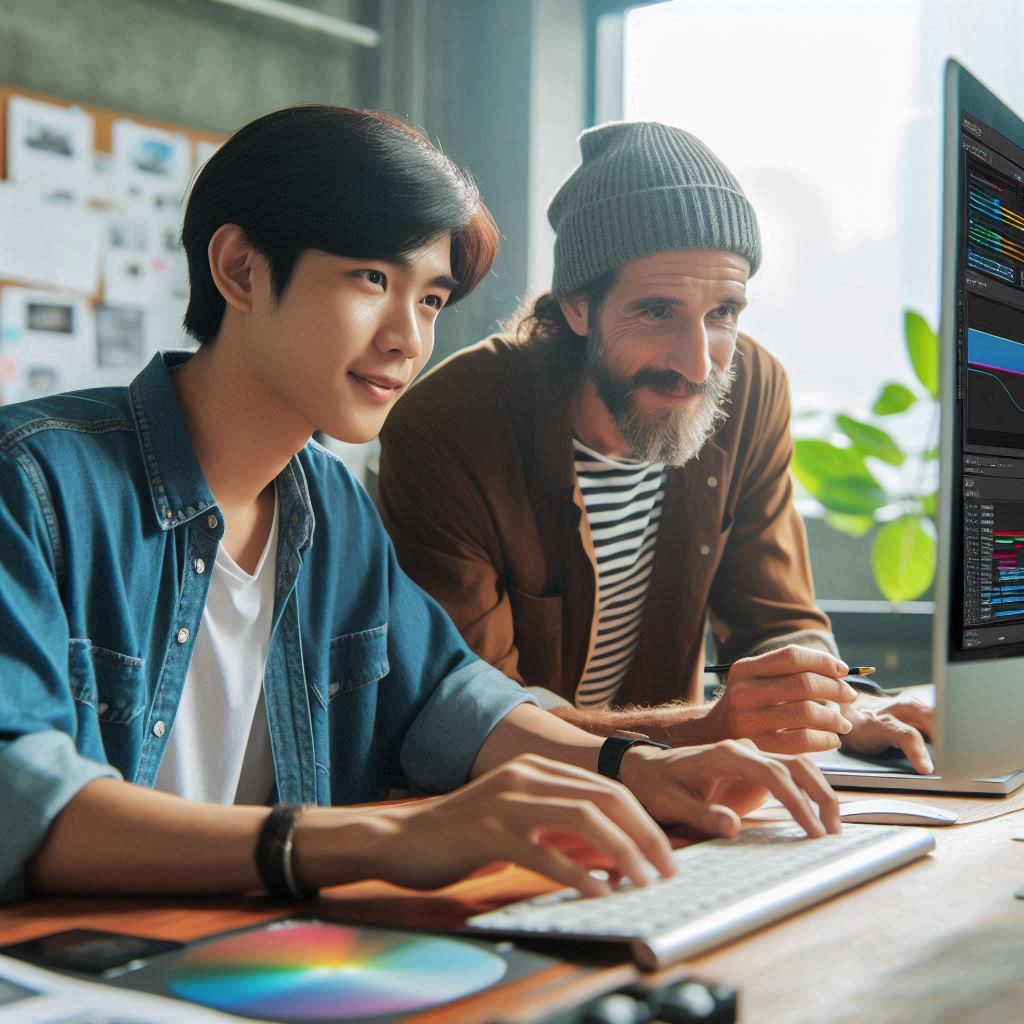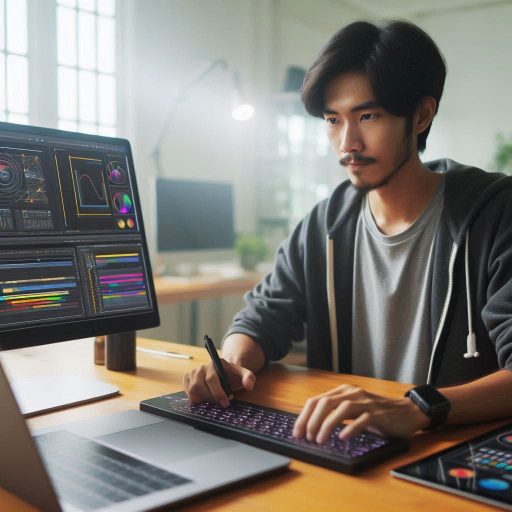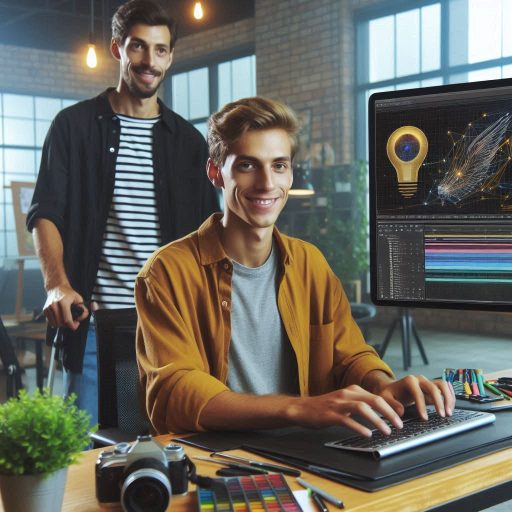Introduction
Motion graphics design combines art and technology to create captivating visual content.
It encompasses animation, graphics, and text to tell a story.
Motion graphics often enhance videos, advertisements, and presentations.
They bring static images to life through movement and effects.
Designers use software like Adobe After Effects and Cinema 4D to create these visuals.
A motion graphics designer plays a crucial role in visual storytelling.
They collaborate with clients, marketers, and creative teams to understand project goals.
This collaboration helps them create visuals that align with the overall message.
Designers brainstorm ideas and develop concepts based on client requirements.
They sketch storyboards to visualize their ideas before moving forward.
This planning phase allows for adjustments and refinements.
Once the concept is approved, designers start the production process.
They gather assets, such as images, videos, and sound effects, to enhance their designs.
A keen eye for detail is essential during this stage.
Designers work meticulously to ensure all elements work harmoniously together.
They use color, typography, and animation techniques to create a cohesive look.
Overview of a typical day in the life of a motion graphics designer
Start with Morning Routine and Preparations for the Day
A motion graphics designer‘s day begins with a structured morning routine.
They typically wake up early to maximize productivity.
After a quick breakfast, they prepare their workspace.
This includes organizing their design tools and software.
A tidy environment helps spark creativity and focus.
Once settled, they review their schedule for the day.
This often includes deadlines for ongoing projects and meetings with team members.
The designer checks emails for any updates or client feedback.
They prioritize tasks based on urgency and importance.
The Tasks and Projects a Designer May Work on Throughout the Day
The first task usually involves brainstorming ideas for new projects.
Designers gather inspiration from various sources, including social media, design blogs, and online galleries.
They sketch initial concepts and plan animations, keeping the target audience in mind.
This phase is crucial for setting the project’s creative direction.
As the day progresses, the designer dives into the actual animation work.
They utilize software like Adobe After Effects or Cinema 4D to create dynamic visuals.
They carefully animate graphics, paying attention to timing and fluidity.
This process requires patience and precision, as each movement contributes to the overall impact.
Any Meetings or Collaborations with Team Members
Collaboration is vital in a designer‘s role.
Throughout the day, they attend team meetings to discuss project updates.
These meetings often include brainstorming sessions with colleagues and creative directors.
Designers present their work, receive feedback, and make necessary adjustments.
Midday, they take short breaks to recharge.
These breaks help maintain focus and prevent burnout.
They may step outside for fresh air or grab a snack.
This routine refreshes their mind for the next round of creativity.
After lunch, they might engage in client meetings via video calls.
During these calls, they showcase their designs and discuss revisions.
Clear communication is essential for ensuring client satisfaction.
Designers also receive input on changes and new ideas, fostering collaboration.
As the afternoon rolls in, they continue refining their animations based on feedback.
This may involve tweaking graphics, adjusting colors, or altering motion paths.
Each small change can significantly enhance the final product.
Toward the end of the day, designers compile their work into presentation formats.
They prepare project files for handoff to other team members or clients.
A successful day concludes with a final check of emails and task lists.
Before logging off, designers often set goals for the following day.
This practice helps maintain momentum and fosters continued creativity.
Ultimately, each day as a motion graphics designer brings unique challenges and opportunities, making the role both dynamic and rewarding.
Read: Networking Events for Costume Designers
Tools and Software Used by Motion Graphics Designers
Motion graphics designers rely on various tools and software to bring their creative visions to life.
Commonly Used Software
Among the most popular software is Adobe After Effects.
This program allows designers to create stunning animations and visual effects.
It provides a robust platform for compositing and motion design.
Designers use After Effects to animate text, images, and other graphic elements.
Another essential tool is Adobe Photoshop.
Designers use Photoshop for creating and editing graphics and images.
This software helps in preparing assets that can be animated later.
Photoshop allows designers to manipulate images, ensuring they fit seamlessly into their animations.
It provides a vast range of brushes, filters, and effects for detailed graphic work.
Adobe Illustrator is also a staple in the motion graphics designer’s toolkit.
This vector-based software allows designers to create scalable graphics without losing quality.
Designers often use Illustrator to craft logos and icons for use in animations.
Its integration with other Adobe software streamlines the workflow for motion graphics projects.
Importance of Staying Up-to-Date
Staying up-to-date with new tools and technologies is crucial for motion graphics designers.
The industry is constantly evolving, with new software versions and features released regularly.
By keeping current, designers can leverage advanced tools that enhance their work.
New technologies often introduce more efficient workflows, allowing designers to complete projects faster.
Staying informed about trends can also spark creativity and inspire innovative design solutions.
Necessary Hardware and Equipment
In addition to software, motion graphics designers require specific hardware and equipment.
A powerful computer is essential for running graphic-intensive applications smoothly.
Designers often choose machines with high processing power and ample RAM.
A graphics card with good performance is also crucial for rendering complex animations.
Many designers use drawing tablets for precise control during the design process.
These tablets allow for natural drawing and designing, making it easier to create intricate details.
Additionally, a high-resolution monitor helps designers see their work clearly, ensuring accurate color representation.
Some designers invest in video editing software like Adobe Premiere Pro.
This software complements motion graphics work by allowing designers to edit video content seamlessly.
Integrating animations into video projects often requires a robust editing tool.
In short, motion graphics designers use a range of software tools and hardware to succeed in their roles.
Adobe After Effects, Photoshop, and Illustrator are among the most commonly used software.
Staying updated with new tools is vital for enhancing skills and creativity.
Additionally, powerful computers, drawing tablets, and video editing software support their workflow.
By mastering these tools, designers can create captivating animations that resonate with audiences.
Read: Visual Merchandising: Best Practices for Beginners
Creative process of a motion graphics designer
A motion graphics designer’s creative process begins with brainstorming ideas.
Designers often draw inspiration from various sources, such as films, art, and nature.
They keep a sketchbook or digital notes to jot down thoughts whenever inspiration strikes.
Collaborating with other creatives can also spark innovative ideas.
Team discussions often lead to unique concepts that may not emerge in isolation.
How Designers Come Up with Ideas for Projects
Once designers settle on a concept, they create storyboards to visualize their ideas.
Storyboarding helps them plan the flow of the animation.
Designers sketch key frames that outline essential moments in the project.
This visual representation serves as a guide throughout the animation process.
It also allows them to communicate their vision effectively to clients and team members.
The Process of Creating Storyboards and Visual Concepts
After completing the storyboard, designers develop visual concepts.
They select color schemes, typography, and graphic elements that align with the project‘s theme.
This phase is crucial for establishing the overall style of the motion graphics.
Designers often create style frames, which are detailed illustrations of key scenes.
These frames provide a clearer picture of the final look and feel of the animation.
The Importance of Feedback and Revisions in the Creative Process
Feedback plays a vital role in refining designs.
Designers present their storyboards and style frames to clients and stakeholders.
They encourage open discussions about the concepts to gather insights and suggestions.
Constructive criticism helps identify potential issues and areas for improvement.
Designers remain adaptable and receptive to changes during this stage.
Revisions often follow initial feedback.
Designers may adjust animations, refine graphics, or modify color palettes based on input.
They must balance their creative vision with client expectations.
This iterative process can lead to significant enhancements in the final product.
Designers understand that revisions can be time-consuming but essential for achieving the best outcome.
Throughout the creative process, designers stay organized.
They maintain a timeline for project milestones and deadlines.
Effective time management helps them allocate sufficient time for revisions and adjustments.
Additionally, they often collaborate with sound designers and editors to integrate audio elements.
This collaboration enhances the overall impact of the motion graphics.
Most importantly, the creative process of a motion graphics designer is dynamic and collaborative.
Designers generate ideas through brainstorming and inspiration from various sources.
They translate these ideas into storyboards and visual concepts.
Feedback and revisions play crucial roles in refining their work.
Ultimately, this process ensures that the final product resonates with the audience and meets client expectations.
Read: Famous Costume Designers in Hollywood

Collaboration with other team members
Working as a motion graphics designer involves collaborating with various professionals to bring creative projects to life.
Let’s dive into how motion graphics designers work harmoniously with animators, illustrators, and video editors.
How Motion Graphics Designers Work with Other Professionals Such as animators, illustrators, and video editors
Working with animators
Motion graphics designers often team up with animators to create engaging visuals that captivate audiences.
They work together to develop animations that add movement and interest to graphics.
This partnership allows for the seamless integration of static visuals into lively, dynamic content.
Working with illustrators
Collaborating with illustrators is essential for motion graphics designers to incorporate unique and eye-catching artwork into their projects.
By working closely with illustrators, designers can enhance the visual appeal of their animations and create a cohesive look that resonates with viewers.
Working with video editors
Video editors play a crucial role in the post-production process, refining motion graphics designers’ work to perfection.
By working hand in hand with video editors, designers can ensure that their animations are seamlessly integrated into video content, creating a seamless viewing experience for audiences.
Importance of effective communication and teamwork
Effective communication and teamwork are the pillars of successful collaborations in the world of motion graphics design.
Let’s explore why these elements are essential for completing projects efficiently and achieving outstanding results.
Transform Your Career Today
Unlock a personalized career strategy that drives real results. Get tailored advice and a roadmap designed just for you.
Start NowClear communication
Clear communication is crucial in ensuring that all team members are on the same page regarding project goals and timelines.
By articulating ideas effectively and providing regular updates, motion graphics designers can streamline the creative process and avoid misunderstandings that may lead to delays or errors.
Collaborative synergy
Teamwork is essential for harnessing the collective creativity and expertise of each team member.
By pooling their skills and working together towards a common goal, motion graphics designers can leverage diverse perspectives to produce innovative and impactful visuals that exceed client expectations.
Efficient problem-solving
Effective communication and teamwork enable motion graphics designers to address challenges proactively and find creative solutions.
By fostering an environment of open dialogue and mutual support, team members can brainstorm ideas, troubleshoot issues, and adapt to changing project requirements more effectively.
Successful collaborations and their impact on the final product
Successful collaborations among motion graphics designers, animators, illustrators, and video editors can elevate the quality of a project and enhance its overall impact.
Let’s explore some examples of successful collaborations and how they contribute to creating exceptional final products.
Case study: Animated explainer video
In a recent project, a motion graphics designer collaborated with an animator to create an animated explainer video for a tech startup.
By combining their skills and expertise, they produced a visually stunning video that effectively communicated the client’s complex ideas in a simple, engaging manner.
Case study: Branding campaign
Another example of a successful collaboration involved a motion graphics designer teaming up with an illustrator to develop a branding campaign for a fashion company.
By blending their talents, they crafted a series of animated visuals that captured the essence of the brand and resonated with its target audience, resulting in increased brand visibility and customer engagement.
Case study: Video content for social media
In a third case study, a motion graphics designer collaborated with a video editor to create interactive video content for a social media marketing campaign.
By combining their expertise, they produced visually compelling videos that drew in audiences and generated a high level of user engagement, effectively promoting the client’s products and services.
Collaboration is at the heart of motion graphics design, enabling designers to leverage the talents of animators, illustrators, and video editors to create captivating visuals that resonate with audiences.
By fostering effective communication and teamwork, motion graphics designers can achieve exceptional results and deliver outstanding projects that leave a lasting impression.
Read: Freelance vs. In-House Costume Design Jobs
Discover More: How to Get Noticed as a Fashion Designer
The Importance of Time Management and Organization
Time management and organization are crucial for motion graphics designers.
Designers often juggle multiple projects with tight deadlines.
Effective time management allows them to allocate time efficiently.
This helps ensure that they meet client expectations and project requirements.
The Need for Meeting Deadlines and Managing Multiple Projects Simultaneously
Meeting deadlines is essential in the creative industry.
Clients rely on designers to deliver high-quality work on time.
Late submissions can damage professional relationships and reputations.
Thus, mastering time management skills is vital for success in this field.
To manage multiple projects effectively, designers should prioritize tasks.
Creating a detailed to-do list helps keep projects organized.
This list can include deadlines, project details, and priority levels.
By breaking down tasks into manageable steps, designers can focus on one project at a time.
Tips and Strategies for Staying Organized and Prioritizing Tasks
Using digital tools can significantly enhance organization.
Software like Trello or Asana allows designers to track progress and deadlines.
Setting reminders for upcoming tasks can also prevent last-minute rushes.
Designers can visualize their workload and allocate time accordingly.
Establishing a daily routine promotes consistency.
Starting the day with a review of tasks helps set priorities.
Designers should allocate specific time blocks for each project.
This approach prevents distractions and improves focus.
Designers should also consider using the Pomodoro Technique.
This method involves working in focused intervals, followed by short breaks.
These breaks help maintain energy and creativity throughout the day.
This technique can enhance productivity and prevent burnout.
Communication plays a significant role in time management.
Designers should maintain open channels with clients and team members.
Regular check-ins help ensure everyone is on the same page.
This practice can prevent misunderstandings and last-minute changes.
The Impact of Time Management on the Quality of Work Produced
The impact of time management on the quality of work is profound.
Organized designers produce higher-quality work because they avoid rushed decisions.
They can dedicate time to refining details and enhancing creativity.
Good time management allows for thorough reviews and revisions.
Quality work leads to satisfied clients and repeat business.
Happy clients often refer designers to others, creating new opportunities.
Thus, effective time management is not only about meeting deadlines but also about maintaining a positive reputation.
In a nutshell, time management and organization are vital for motion graphics designers.
By mastering these skills, they can navigate multiple projects with ease.
This approach leads to high-quality work and lasting client relationships.
Ultimately, effective time management shapes a successful career in motion graphics design.
Challenges faced by motion graphics designers
Motion graphics designers encounter various challenges daily.
These obstacles can impact their creativity and productivity.
Understanding these hurdles can help aspiring designers navigate their careers effectively.
Common Obstacles Such as Creative Blocks, Technical Issues, and Client Feedback
One common challenge is creative block.
Designers often struggle to generate new ideas, leading to frustration.
This block can occur due to tight deadlines or lack of inspiration.
To overcome this, many designers take breaks to refresh their minds.
They may also seek inspiration from different sources, such as art, film, or nature.
Engaging in creative exercises, like sketching or brainstorming, can also help spark new ideas.
Technical issues present another significant challenge.
Motion graphics rely heavily on software and technology.
Designers frequently face problems like software crashes or compatibility issues.
These problems can halt progress and create stress.
To combat this, designers should stay updated on software updates and best practices.
Building a solid understanding of technical skills is crucial.
Many designers invest time in learning through online courses or tutorials.
They also join communities to share knowledge and solutions to common technical problems.
Client feedback can also pose challenges.
Designers often receive feedback that conflicts with their vision.
Clients may have specific ideas that differ from the designer’s style.
Handling criticism gracefully is essential for maintaining professional relationships.
Successful designers actively listen to client feedback and incorporate it where appropriate.
They ask questions to clarify client expectations, ensuring they deliver the desired result.
This collaboration often leads to innovative solutions that satisfy both the designer and the client.
How Designers Overcome Challenges and Continue to Innovate in Their Work
Innovation in motion graphics requires adaptability.
Designers must embrace change and be open to new techniques.
Experimenting with different styles and tools can lead to fresh ideas.
Networking with other professionals can provide new insights and inspiration.
Joining online forums or attending industry events helps designers stay connected.
Advice for Aspiring Motion Graphics Designers on How to Navigate These Challenges
For aspiring motion graphics designers, navigating these challenges is vital.
Start by cultivating a growth mindset.
View obstacles as opportunities for learning and development.
Surround yourself with a supportive community that encourages growth.
Connect with other designers for feedback and collaboration.
Additionally, prioritize self-care to combat creative blocks.
Maintain a balance between work and personal life to foster creativity.
Regular breaks can help you recharge and return with renewed focus.
Lastly, always seek to improve your technical skills.
Familiarize yourself with the latest software and trends to stay competitive.
By understanding and addressing these challenges, aspiring motion graphics designers can thrive in their careers.
With persistence and creativity, they can overcome obstacles and produce stunning work.
Conclusion
As we conclude our exploration into the day in the life of a motion graphics designer, it’s important to recap some key points that were discussed.
Throughout this blog post, we have highlighted the creativity, collaboration, and problem-solving skills that are essential for a successful career in motion graphics design.
Remember, motion graphics designers play a crucial role in bringing ideas to life through dynamic visuals that captivate audiences and convey messages effectively.
If you have a passion for creativity, enjoy working in a collaborative environment, and thrive on solving visual challenges, then a career in motion graphics design might be the perfect fit for you.
We encourage you to explore the field further, seek out opportunities for learning and growth, and consider pursuing a career in motion graphics design.
The possibilities are endless, and your creativity can truly shine in this exciting and dynamic industry.




